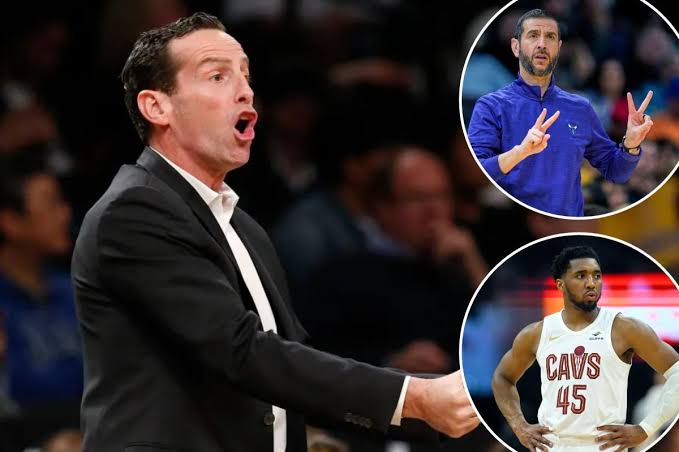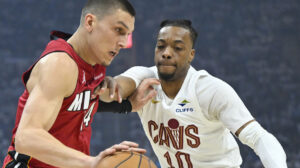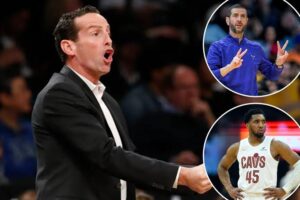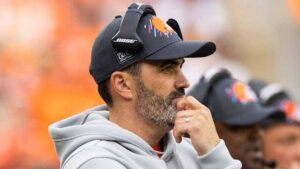
Kenny Atkinson has a lot of options to choose from when crafting his rotation for this deep Cleveland Cavaliers team.
The Cavaliers have the talent to beat anyone in the league, and a significant part of Atkinson’s job over the next two months is deciding which players to put on the court. Do the Cavs play big, with De’Andre Hunter or Dean Wade at the 3? Do they go small, putting Max Strus or Isaac Okoro at the 4? How many minutes do Jarrett Allen and Evan Mobley play together? Donovan Mitchell and Darius Garland?
How he manages his rotations to attack opponent weaknesses and mitigate their strengths will be an ongoing story and will likely decide whether or not Cleveland wins it all. Atkinson needs to make rotation decisions based on what he thinks will best win basketball games, not caring about criticism or appearances or even things like “tenure” and “standing” — the best five players need to be on the court at the right times. The best playoff coaches make those decisions irrespective of those external factors.
Atkinson has already waded into those deep waters, making a surprising rotation decision in Game 1 of the Cavaliers’ opening round playoff series against the Miami Heat. He leaned into lineups with his four stars split into pairs, as he has done for most of the season. The four-man grouping of Mobley, Mitchell, Garland and Allen shared the court for just 17 minutes altogether, which is impressive given that all four players saw at least 30 minutes in the game. And it worked, as the Cavaliers broke the game open late en route to a 121-100 victory.
Very early in the first and third quarters Atkinson pulled Mobley and Mitchell onto the bench, inserting bench players around Garland and Allen. Then a few minutes later he swapped them, giving Garland and Allen a rest and putting Mobley and Mitchell back in.
That’s not a new approach, even if Atkinson leaned into it even more than usual this game. This is not all that common of a strategy; teams may rotate one or two players around their stars but they have a core that plays heavy minutes. Not every team is the New York Knicks, who play their starters all together for the vast majority of the game, but the Cavaliers purposefully stagger their stars for most of the game.
The reason they can do that is they are incredibly deep. The Cavaliers have a number of reliable two–way players to fill in around their star pairings. Max Strus and De’Andre Hunter are high-dollar two-way wings. Dean Wade is one of their best defenders and strong enough to match up with larger forwards. Isaac Okoro is one of the league’s better point-of-attack defenders. Ty Jerome is insanely efficient and every bit as impactful as the team’s star guards on offense.
Against the Heat, however, Atkinson made an unusual decision, one that looked risky at face value and was not one he had leaned into often during the season. As he rotated players around those star pairings, one player saw increased minutes at small forward and was tasked as the primary defender on Miami All-Star guard Tyler Herro when on the court: none other than Sam Merrill
Kenny Atkinson played Sam Merrill a lot
Sam Merrill, the team’s 10th-man who was not even a lock to see rotation minutes at all, instead was on the court for a whopping 24 minutes, finishing +11 for the game. He is a valuable offensive player because of his movement shooting, forcing opponents to defend him closely or risk a high-percentage 3-pointer swishing through the net.
Merrill was active on offense even without the ball, and when the Heat ran him off the line he responded with making plays for others, tallying four assists while going a sedate but efficient 2-for-4 from 3-point range. Even without the ball Merrill is providing space for his teammates to go to work.
What was even more shocking, however, was that Atkinson leaned on Merrill as the Tyler Herro stopper. The Heat’s one path to efficient offense is riding Herro, who dropped a combined 68 points in the Heat’s two Play-In victories. Given that the Cavs’ guard rotation consists of three below-average defenders in Mitchell, Garland and Jerome, it seemed likely that either (1) the Cavaliers would lean into offense and let Herro get his, or (2) play Isaac Okoro extended minutes to shut him down.
Atkinson chose door No. 3, putting Sam Merrill on Herro. Merrill was an undrafted free agent who languished in the G League before the Cavaliers signed him to a full deal. He is not a superb athlete and was ignored largely because of a lack of defense — and suddenly he becomes a stopper for the No. 1 team in the East.
Merrill did an excellent job, teaming up with Max Strus and Okoro to hold Herro to 7-of-18 shooting and three turnovers for the game. The fact that Atkinson could play Merrill for 50 percent of the game proves just how well he held up, playing out of position and defending at a really good level. He has grown tremendously on that end of the court.
It’s unlikely that Sam Merrill plays half of the game moving forward, and his role will look different in future series when the Cavaliers need more size on the court. In Game 1, and perhaps against Miami in general, the Cavs can lean into their very best offensive lineups, and Merrill was the key to unlocking them in Game 1.
A bold move from Atkinson paid off in a big way. He was the best coach in the league during the regular season, and he is backing that up in the playoffs already.





